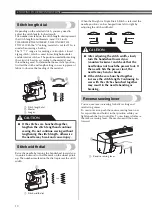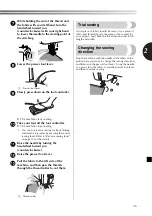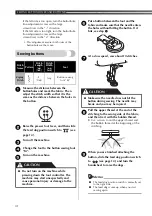
SEWING BASICS
—
—
—
—
—
—
—
—
—
—
—
—
—
—
—
—
—
—
—
—
—
—
—
—
—
—
—
—
—
—
—
—
—
—
—
—
—
—
—
—
—
—
—
—
—
—
—
—
—
—
—
—
—
—
—
—
—
—
—
—
—
—
—
—
—
—
—
—
—
—
—
—
—
—
—
—
—
—
—
—
—
—
—
—
—
—
—
—
—
—
—
—
—
—
—
—
—
—
—
—
—
—
—
—
—
—
—
—
—
—
—
—
—
—
—
—
—
—
—
—
—
—
—
—
—
—
—
—
—
—
—
—
—
—
—
—
—
—
—
—
—
—
—
—
—
—
—
—
—
—
—
—
—
—
—
—
—
—
—
—
—
—
—
—
—
—
—
—
—
—
—
—
—
—
—
—
—
—
—
—
—
—
—
—
—
—
—
—
—
—
—
—
—
—
—
—
—
—
—
—
—
—
—
—
—
—
—
—
—
—
—
—
—
—
—
—
—
—
—
—
—
—
—
—
—
—
—
—
—
—
—
27
Sewing thick fabrics
■
If the fabric does not fit under the presser foot
If the fabric does not fit easily under the presser foot,
raise the presser foot lever even higher to bring the
presser foot to its highest position.
■
If thick seams are being sewn and the fabric
does not feed at the beginning of stitching
The fabric may not feed when thick seams are being
sewn and the presser foot is not level.
In this case, use the presser foot locking pin (black
button on the left side of zigzag foot “J”) so that the
presser foot remains level while sewing, allowing
the fabric to be fed smoothly.
1
Sewing direction
2
Misalignment
1
Raise the presser foot lever.
2
Align the beginning of stitching, and then
position the fabric.
3
While holding zigzag foot “J” level, hold
the presser foot locking pin (black button
on the left side) pressed in, and lower the
presser foot lever.
3
Presser foot locking pin (black button)
4
Release the presser foot locking pin (black
button).
X
The presser foot remains level, allowing
the fabric to be fed.
X
After the seam is sewn, the presser foot will
return to its original angle.
CAUTION
●
If fabric more than 6 mm (15/64 inch)
thick is sewn or if the fabric is pushed
with too much force, the needle may
bend or break.
Summary of Contents for 888-X39
Page 32: ...SEWING BASICS 31 ...
Page 82: ...FUNCIONES DE COSTURA BÁSICAS 31 ...
Page 102: ......
Page 103: ......
















































